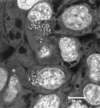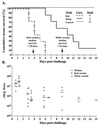Variations in the csgD promoter of Escherichia coli O157:H7 associated with increased virulence in mice and increased invasion of HEp-2 cells - PubMed (original) (raw)
Variations in the csgD promoter of Escherichia coli O157:H7 associated with increased virulence in mice and increased invasion of HEp-2 cells
Gaylen A Uhlich et al. Infect Immun. 2002 Jan.
Abstract
Promoter alterations in the csgD gene of Escherichia coli O157:H7 strains ATCC 43894 and ATCC 43895 are associated with variations in curli expression and the ability to bind Congo red dye. Red variants of each strain were more invasive for cultured HEp-2 cells than were white variants. An ATCC 43895 red variant was more virulent than a white variant in a mouse model. However, there were no differences in Shiga toxin production between red and white variants.
Figures
FIG. 1.
Comparative percentage of HEp-2 cell invasion (with 95% confidence intervals [error bars]) by various bacterial strains. The number in parentheses below each strain is the number of experimental replicates. EHEC, enterohemorrhagic E. coli.
FIG. 2.
Confocal microscopic image of HEp-2 cells infected with the ATCC 43895 Congo red-binding variant. The optical section includes an intracellular plane that contains numerous bacterial cells adjacent to nuclei.
FIG. 3.
Survival curves of (A) and fecal shedding by (B) CD-1 mice orally challenged with red or white variants of streptomycin-resistant ATCC 43895 E. coli O157:H7 (concentration, 109 CFU/ml) compared to those of control mice (LB broth). Control mice did not shed E. coli O157:H7; each data point represents an individual mouse. There were seven mice per group.
FIG. 4.
Comparative Vero cell Stx assay for red (curliated) and white (noncurliated) variants of ATCC 43895 E. coli O157:H7. NC, negative control; PC, positive control.
Similar articles
- Mutations in the csgD promoter associated with variations in curli expression in certain strains of Escherichia coli O157:H7.
Uhlich GA, Keen JE, Elder RO. Uhlich GA, et al. Appl Environ Microbiol. 2001 May;67(5):2367-70. doi: 10.1128/AEM.67.5.2367-2370.2001. Appl Environ Microbiol. 2001. PMID: 11319125 Free PMC article. - [Construction and immunization of a enterohemorrhagic Escherichia coli O157 attenuated].
Liu J, Sun Y, Feng SZ. Liu J, et al. Sheng Wu Gong Cheng Xue Bao. 2007 Mar;23(2):211-7. Sheng Wu Gong Cheng Xue Bao. 2007. PMID: 17460890 Chinese. - Transcriptional Activator OvrA Encoded in O Island 19 Modulates Virulence Gene Expression in Enterohemorrhagic Escherichia coli O157:H7.
Liu B, Wang J, Wang L, Ding P, Yang P, Yang B. Liu B, et al. J Infect Dis. 2020 Feb 18;221(5):820-829. doi: 10.1093/infdis/jiz458. J Infect Dis. 2020. PMID: 31630185 - Regulatory elements of stx2 gene and the expression level of Shiga-like toxin 2 in Escherichia coli O157:H7.
Suardana IW, Pinatih KJP, Widiasih DA, Artama WT, Asmara W, Daryono BS. Suardana IW, et al. J Microbiol Immunol Infect. 2018 Feb;51(1):132-140. doi: 10.1016/j.jmii.2016.04.006. Epub 2016 May 13. J Microbiol Immunol Infect. 2018. PMID: 27317410 - Implication of virulence factors in Escherichia coil O157:H7 pathogenesis.
LeBlanc JJ. LeBlanc JJ. Crit Rev Microbiol. 2003;29(4):277-96. doi: 10.1080/713608014. Crit Rev Microbiol. 2003. PMID: 14636040 Review.
Cited by
- Conditional expression of flagellar motility, curli fimbriae, and biofilms in Shiga toxin- producing Escherichia albertii.
Carter MQ, Carychao D, Lindsey RL. Carter MQ, et al. Front Microbiol. 2024 Sep 9;15:1456637. doi: 10.3389/fmicb.2024.1456637. eCollection 2024. Front Microbiol. 2024. PMID: 39318426 Free PMC article. - Evolution of cyclic di-GMP signalling on a short and long term time scale.
Römling U, Cao LY, Bai FW. Römling U, et al. Microbiology (Reading). 2023 Jun;169(6):001354. doi: 10.1099/mic.0.001354. Microbiology (Reading). 2023. PMID: 37384391 Free PMC article. - A One Health Perspective for Defining and Deciphering Escherichia coli Pathogenic Potential in Multiple Hosts.
García A, Fox JG. García A, et al. Comp Med. 2021 Feb 1;71(1):3-45. doi: 10.30802/AALAS-CM-20-000054. Epub 2021 Jan 8. Comp Med. 2021. PMID: 33419487 Free PMC article. Review. - Quantitating denaturation by formic acid: imperfect repeats are essential to the stability of the functional amyloid protein FapC.
Christensen LFB, Nowak JS, Sønderby TV, Frank SA, Otzen DE. Christensen LFB, et al. J Biol Chem. 2020 Sep 11;295(37):13031-13046. doi: 10.1074/jbc.RA120.013396. Epub 2020 Jul 21. J Biol Chem. 2020. PMID: 32719003 Free PMC article. - Comparative genomics reveals structural and functional features specific to the genome of a foodborne Escherichia coli O157:H7.
Sharma VK, Akavaram S, Schaut RG, Bayles DO. Sharma VK, et al. BMC Genomics. 2019 Mar 8;20(1):196. doi: 10.1186/s12864-019-5568-6. BMC Genomics. 2019. PMID: 30849935 Free PMC article.
References
- Bian, Z., A. Brauner, Y. Li, and S. Normark. 2000. Expression of and cytokine activation by Escherichia coli curli fibers in human sepsis. J. Infect. Dis. 181: 602–612. - PubMed
- Donnenberg, M. S., A. Donohue-Rolfe, and G. T. Keusch. 1989. Epithelial cell invasion: an overlooked property of enteropathogenic Escherichia coli (EPEC) associated with the EPEC adherence factor. J. Infect. Dis. 160: 452–459. - PubMed
- Games, P. A., and J. F. Howell. 1976. Pairwise multiple comparison procedures with unequal n’s and/or variances. J. Ed. Stat. 1: 113–125.
MeSH terms
Substances
LinkOut - more resources
Full Text Sources
Medical



